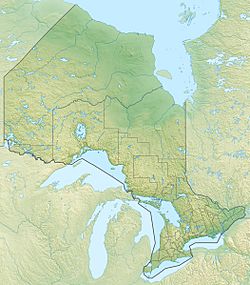Mississippi Lake facts for kids
Quick facts for kids Mississippi Lake |
|
|---|---|
| Location | Lanark County, Ontario |
| Coordinates | 45°04′01″N 76°09′56″W / 45.06694°N 76.16556°W |
| Primary inflows | Mississippi River |
| Primary outflows | Mississippi River |
| Basin countries | Canada |
| Shore length1 | 55.9 km (34.7 mi) |
| Surface elevation | 134 m (440 ft) |
| Islands | Loon Island, Greig Island, Burnt Island, Pine Island, Wilson islands, The Two Crabs, Willis Island, Long View Island, Morris Island, Dinkey-Dooley Island (real name) and Aberdeen Island |
| 1 Shore length is not a well-defined measure. | |
Mississippi Lake is a beautiful lake located in Lanark County in Ontario, Canada. The Mississippi River flows right through it, heading northeast and then north. Many smaller streams, like Cranberry Creek, McCrearys Creek, and McGibbon Creek, also flow into the lake from nearby forests and farms.
One cool thing about Mississippi Lake is how it was formed. It's a leftover from the ancient Champlain Sea. This sea covered eastern Ontario after the last ice age ended. You can still see traces of its old shoreline near the lake's north side!
Contents
Exploring Mississippi Lake's History
People from Europe started settling around Mississippi Lake around 1816. They moved into areas like Franktown, which is just north of the Rideau River.
How Did People Travel on the Lake?
Between the 1860s and 1920s, steamboats were a popular way to get around. These boats connected the towns of Carleton Place and Innisville across the lake. Imagine traveling by steamboat back then!
Discovering Mississippi Lake's Wetlands
Mississippi Lake is home to two very important natural areas called wetlands. Wetlands are like special watery lands where many plants and animals live.
The Innisville Wetland: A Natural Treasure
The biggest wetland is at the west end of the lake. This is where the Mississippi River enters the lake through the Innisville wetland. It's one of the largest wetlands in all of Lanark County! This area is so important that it's called an Area of Natural and Scientific Interest.
- Inside this wetland, you'll find the Mississippi Lake National Wildlife Area.
- It has huge areas of silver maple trees that get flooded in the spring.
- Closer to the shore, there are important areas of marsh and water plants.
Wetlands on the Western Shore
The western shore of the lake also has amazing wetlands. This includes areas like Kinch Bay, Code Bay, and King Bay. These wetlands have everything from silver maple swamps to large areas filled with water plants.
Wildlife at Mississippi Lake
Mississippi Lake is a fantastic place to spot many different kinds of birds and other animals.
Birds You Might See
- Loons: These birds are known for their unique calls.
- Bald Eagles: You might see these majestic birds soaring high above.
- Ospreys: These are fishing hawks that dive into the water to catch fish.
- Herons: These tall, long-legged birds often stand still in the water, waiting for their next meal.
Ospreys and herons also build their nests in areas near the lake, like the Scotch Corners Wetland.
Special Animals Living Here
The lake is home to a special kind of turtle called the Blanding's Turtle. This turtle is considered provincially significant, meaning it's important to protect them. For these turtles to survive long-term, they need enough safe places to lay their eggs.
What Happened to the Eels?
Long ago, many eels lived in Mississippi Lake. However, dams built downstream for hydroelectric power have almost completely stopped eels from reaching the lake and the river system.


